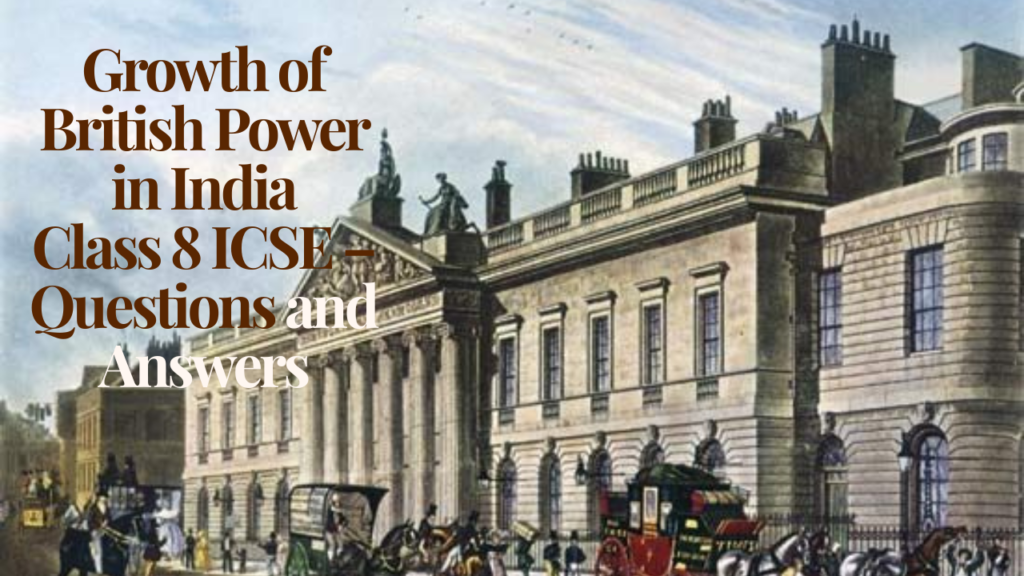Chapter 3: Expansion of the British Rule
Fill in the Blanks
The Battle of Plassey took place in 1757.
Mysore was a rising power in the south under Haider Ali.
Tipu Sultan was killed on the battlefield of Seringapatam.
The Governor-General Lord Dalhousie introduced a new policy known as the Doctrine of Lapse.
Warren Hastings became the first Governor-General of India in 1773.
Match the Following
| Column A | Column B |
|---|---|
| Tipu Sultan | Tiger of Mysore |
| Lord Dalhousie | Doctrine of Lapse |
| Ranjit Singh | Founder of the Sikh Kingdom |
| Lord Wellesley | Subsidiary Alliance |
| Warren Hastings | First Governor-General of India |
Write whether the Statements are True or False
By the second half of the 19th century, the English East India Company had full control over almost the whole of the Indian subcontinent. — True
Tipu Sultan died fighting the Third Anglo-Mysore War. — False (He died in the Fourth Anglo-Mysore War.)
By the Charter Act of 1813, Rs 1 lakh was set aside for imparting education to Indians. — True
The British had to face challenges from the Marathas, Sikhs, and Tipu Sultan. — True
Murshid Quli Khan was the Diwan of Aurangzeb. — True
Tick the Correct Answer
Who introduced the Doctrine of Lapse?
✅ Lord Dalhousie
Commander-in-Chief of Nawab Siraj-ud-Daulah’s Army?
✅ Mir Jafar
Who captured the Seringapatam Fort?
✅ Lord Cornwallis
Who was the first Governor-General of India in 1773?
✅ Warren Hastings
When was the Charter Act passed?
✅ 1813
Answer the following in 3–4 sentences
Question 1: Why was the Battle of Plassey fought?
Ans: The Battle of Plassey is a historical event that changed the fate of India. It was fought between the Nawab of Bengal, Siraj-ud-Daulah, and the English East India Company. The Nawab suspected the trading activities of the British and opposed their growing influence, which led to the battle.
Question 2: Why was the Battle of Buxar fought?
Ans: The Battle of Buxar (1764) was fought between Mir Qasim, the Nawab of Bengal, and the English East India Company. Initially, Mir Qasim supported the British, but later, he tried to assert his independence, leading to a clash in which he was defeated and fled to Awadh.
Question 3: Who was William Pitt?
Ans: William Pitt was the Prime Minister of England in 1784, under whose leadership Pitt’s India Act was passed to regulate and control the activities of the East India Company in India.
Question 4: Name the powers who signed the Subsidiary Alliance and Doctrine of Lapse.
Ans: The Subsidiary Alliance was accepted by Mysore, Hyderabad, Awadh, the Rajputs, and the Marathas. Under the Doctrine of Lapse, states like Satara, Jhansi, and Nagpur were annexed by the British for lacking a natural male heir.
Question 5: Explain the following: (a) Subsidiary Alliance (b) Doctrine of Lapse
a) Subsidiary Alliance: Introduced by Lord Wellesley in 1798, it required Indian rulers to keep British troops in their territory and pay for their maintenance. They could not make alliances or wage wars without British permission.
b) Doctrine of Lapse: Introduced by Lord Dalhousie, it allowed the British to annex any Indian state without a natural heir, refusing to recognize adopted successors. It caused anger and resentment among Indian rulers, becoming a key cause of the Revolt of 1857.
Answer the following in 5–6 sentences
Question 1: Which policies suggest the establishment of British Supremacy?
Ans: The Subsidiary Alliance by Lord Wellesley and the Doctrine of Lapse by Lord Dalhousie clearly established British supremacy in India. Through these policies, the British extended their control over Indian princely states, either by political treaties or through annexation, laying the foundation of British imperialism in India.
Question 2: What is Dual Government? Name the state in which it was imposed.
Ans: The Dual Government system was introduced in Bengal, Bihar, and Orissa after 1765. The Nawab handled administration, while the East India Company controlled revenue collection. This created inefficiency and exploitation, weakening Indian governance and strengthening British power.
Question 3: How did the Doctrine of Lapse lead to discontentment among Indian rulers?
Ans: The Doctrine of Lapse angered Indian rulers as it deprived them of their kingdoms if they lacked a natural heir. It ignored Indian customs of adoption, causing resentment among rulers and contributing to widespread discontent that fueled the Revolt of 1857.
Question 4: Describe the incident of the Black Hole.
Ans: The Black Hole of Calcutta incident occurred in 1756, when Siraj-ud-Daulah captured Calcutta and imprisoned British officers and civilians in a small dungeon at Fort William. Due to overcrowding and lack of air, most prisoners died overnight. The British later used this incident to justify expansion in Bengal.
Question 5: Describe the administrative policies of the British.
Ans: The British implemented a centralized administrative system, dividing India into provinces under governors. They introduced Western laws, revenue systems like Permanent Settlement and Ryotwari, and civil services to ensure control. These reforms primarily benefited British interests and increased economic exploitation.
Question 6: Can you see a pattern in the establishment of imperialist rule? Analyze.
Ans: Yes, the British followed a systematic imperialist strategy. They entered India through trade, interfered politically using treaties like the Subsidiary Alliance, and then gained direct control through annexations and reforms. Their rule combined economic exploitation, military dominance, and political manipulation, forming a clear imperialist pattern.
Question 7: How did the Charter Act of 1833 affect the English East India Company’s future in India?
Ans: The Charter Act of 1833 ended the East India Company’s commercial activities, transforming it into an administrative body under British government supervision. It marked a turning point, reducing the Company’s power and paving the way for direct British Crown rule after 1858.


